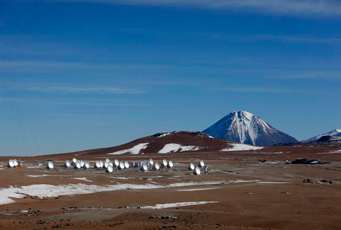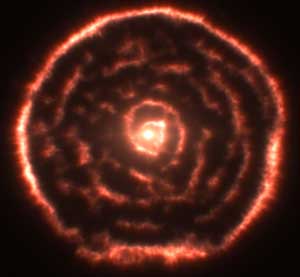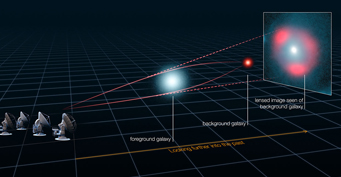The future is now — the world’s most powerful radio telescope array was inaugurated yesterday.

The ALMA observatory perches on the Chajnantor Plateau, which towers at an altitude of 16,600 feet in the Chilean Atacama Desert. This image shows half of the 66 dishes that will soon comprise the world's most powerful radio observatory.
ALMA (ESO / NAOJ / NRAO), C. Padilla
The Atacama Large Millimeter/submillimeter Array (ALMA) has already been astounding the astronomical world since it first came online in 2011, returning the sharpest views ever of the cold universe. But now it’s official: the former construction site is now a full-fledged observatory.
Yesterday afternoon’s ceremony in the Chilean Andes inaugurated ALMA with 50 operational antennas. By the end of 2013, 66 dishes will dot the plateau, placed by two 130-ton transporters fondly named Otto and Lore.
The Chilean president Sebastián Piñera, ALMA staff, and a global assortment of scientists attended the ceremony yesterday, which took place at the observatory’s Operations Support Facility at a still-breathable altitude of 9,500 feet (2,900 meters). The observatory’s dishes are arrayed atop the Chajnantor Plateau at 16,600 feet (5,050 meters).
Officials celebrated ALMA’s revolutionary science reach, which probes a little-explored window on the universe. The millimeter-wavelength radio waves that reach ALMA’s detectors reveal secrets about the formation of everything from stars to galaxies. Astronomers have already captured surprising views of star, planet, and galaxy formation during the preliminary cycle of observations using less than one-fourth of the full array:

A hidden companion star probably created spiral structure in the material around the old star R Sculptoris.
ALMA (ESO / NAOJ / NRAO)
- A spiral-shaped shell around R Sculptoris hints for the first time that this red giant star hosts an unseen companion. Previous observations by other millimeter-wavelength telescopes had revealed only a bland spherical shell.
- Millimeter-size dust grains in a dusty disk ringing a brown dwarf suggest that even stars’ smaller cousins can grow their own planets.
- A sharp view of Fomalhaut’s massive dust ring suggests the presence of two shepherding planets, each with at most three times the mass of Earth.
- Gas streams around a star signal two gas giant planets sweeping up material, a key stage in planet formation.
- The spectrum of the young binary system IRAS 16293-2422 in the Rho Ophiuchi cloud revealed glycolaldehyde, a simple sugar and pre-biotic molecule.
Early Starbursts
And the results keep pouring in: another was announced yesterday in the journal Nature. Joaquin Vieira (Caltech) and his colleagues used ALMA to search for galaxies furiously forming stars in the distant universe.

ALMA examined distant star-factories, gravitationally lensed into rings and arcs by foreground galaxies. The sample contains some of the most faraway starbursts known. Click the image for a larger view.
ALMA (ESO / NRAO / NAOJ), J. Vieira et al.
The team began its search by repurposing the South Pole Telescope survey, designed to study dark energy by mapping out galaxy clusters at millimeter wavelengths. The astronomers selected the brightest sources from this survey and then pointed 16 ALMA dishes at two dozen of them.
Vieira’s team captured detailed images and spectra, resolving the sources’ shapes and their distances from Earth with only one minute of integration time per source. Some of the starburst galaxies are the most distant ever discovered, forming stars at a rate of 500 solar masses per year just 1 billion years after the Big Bang. (Compare that to Milky Way’s paltry present-day rate of 1 solar mass per year).
The existence of bright starbursts in the 1-billion-year-old universe suggests that even 500 million years after the Big Bang the universe had already assembled large reservoirs of dust and gas, ready to be formed into stars. Astronomers think that the first population of stars arose around that time, although they did not expect star formation to be as vociferous at 1 billion years as the ALMA results suggest.

The starburst galaxies were easily visible to ALMA in just one minute of integration time in part because their light bent around a foreground galaxy, which acted as a cosmic lens to magnify the distant sources.
ALMA (ESO / NRAO / NAOJ), L. Cal?ßada (ESO), Y. Hezaveh et al.
But a caveat remains. The sources Vieira’s team selected are so bright that the astronomers suspected they’re magnified. ALMA images proved that suspicion right — each source shows classic signs of being gravitationally lensed by foreground galaxies. As the starburst’s light bends around the foreground galaxy, it magnifies as if through a cosmic-scale lens. That means that, by selecting the brightest galaxies, they basically insured that the sources would be lensed, and therefore more likely to be farther away. Still, the authors say, the result should hold up.
Further study will sort out the systematics, but in the meantime, the existence of distant starbursts still has implications for how early these stellar factories can form.
As ALMA results continue to come in — with increasingly fabulous views of the cold universe — we’ll be featuring ALMA’s futuristic technology and new results in an upcoming Sky & Telescope article.
 0
0









Comments
You must be logged in to post a comment.